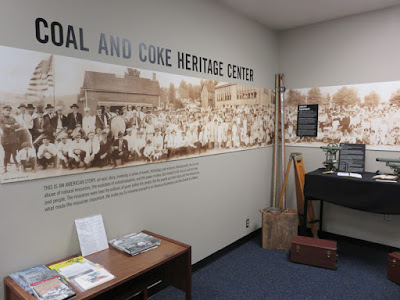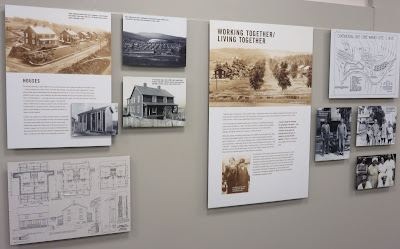Every Labor Day weekend since 1988, one could find me among the pilgrims at the pilgrimage to the Shrine of Our Lady of Perpetual Help at Mount Saint Macrina in Uniontown, Fayette County. This year was not really any different. Except that I usually tack on a few extra days for fieldwork in that area of the state, whereas this year I only did fieldwork on Friday and Monday. Still, some of that activity is worth sharing here.
I arrived in the area mid-afternoon on Friday in order to make my long-awaited first visit to the
Coal & Coke Heritage Center at the Penn State University Fayette Campus near Uniontown (and Leisenring, a pivotal place in the history of Carpatho-Rusyn immigrants in that region). Greeted by the archivist, Amanda Peters, I had about 90 minutes to peruse the attractive and informative museum as well as some of the center's archives and library.
 |
| The place of immigrants in the local communities that supplied the workforce for coal & coke was appropriately highlighted. |
 |
And fortunately Carpatho-Rusyns are acknowledged, as they were one of the primary ethnic groups in the region.
|
 |
| Some equipment used by miners. |
 |
| This area had one of the largest concentrations of Carpatho-Rusyn immigrants in Pennsylvania. |
 |
| The area around Connellsville was one of the earliest Carpatho-Rusyn settlements in western Pennsylvania, primarily developing in Leisenring No. 1, the location of the first Rusyn Greek Catholic church and first Rusyn fraternal benefit society in the region. |
I perused the files on Carpatho-Rusyns, Slovaks, Ukrainians, and other neighboring ethnic groups, not finding too much of interest, but noticing that a few items I wrote for the Carpatho-Rusyn Society many years ago had found their way into the Carpatho-Rusyn folder, such as an issue of the
New Rusyn Times. I found more to focus on in some of the books in their library, such as the excellent series by the
America's Industrial Heritage Project on various company towns, mines, and other industrial sites in parts of southwestern Pennsylvania like Windber, Colver, Johnstown, and Somerset and Westmoreland Counties. I have a few of these books, and have xeroxed others, but I still found some that I don't think I had previously reviewed, so I made sure to photograph some of the most useful sections of those volumes. (Some or even all of them are online in various places, but I haven't yet located them all.)
 |
| Example material found in the America's Industrial Heritage Project studies. |
 |
| Capsule histories of company towns and patches in Westmoreland County as compiled by the AIHP researchers. |
Quite exciting to hear was that the regional ethnic studies collection of the noted Professor Bruce Weston of California University of Pennsylvania is now located at the center. Some of the
oral history material he compiled was published in
Southwestern Pennsylvania magazine, but I'm looking forward to seeing what other oral histories he might have collected but never published. That will require a return visit to the center!

I also bought a copy of
Another Time Another World: Pennsylvania Bituminous Coal, Coke, and Communities (2010), which was "new to me." It's a fascinating look at the bituminous ("soft") coal region in southwestern Pennsylvania, its history, the development of the industry, the immigrant ethnic groups who made up the mining workforce and their communities, and the physical layout and way of life of the company towns. The book did make some mention of Rusyns and their churches that are so prevalent throughout the region, and offered interesting insights such as where the "ethnic churches" and their cemeteries tended to be located in the towns and patches relative to those of other more-established ethnic groups like Germans, Irish, and Welsh.
 |
| Another Time Another World's author wisely included this fascinating portion of a history of St. Stephen's Greek Catholic Church of Leisenring (oldest Rusyn church in southwestern PA), which names the myriad places from which Rusyn immigrants looked to St. Stephen's as their spiritual home, until other Rusyn churches were established in places like Trauger, New Salem/Buffington, Uniontown, Brownsville, Perryopolis, Jacobs Creek, and others. |
My attention then shifted to the pilgrimage at Mount Saint Macrina. Once it was over on Monday, I managed to squeeze in a few useful visits before returning home. These included going to St. Nicholas Byzantine Catholic Church in Brownsville, to improve my photos of the church (inside & out) and to pick up the parish's centennial journal published in 2011.
 |
| St. Nicholas Byzantine/Greek Catholic Church, Brownsville (Washington County), founded 1911 and built 1913-1917. |
 |
| A magnificent stained glass window in the nave of St. Nicholas Church, honoring "Our Lady of Marijapovč" [Máriapócs, Hungary], the most beloved pilgrimage place of Carpatho-Rusyns in Europe, donated by "the faithful from Bereg County." This is one of many such windows in the church donated by members from various villages, counties, and fraternal benefit societies. |
 |
| The parish centennial book largely repeated the history from the 60th anniversary book, but added some useful new material... |
 |
| ...such as this extensive handwritten list of the initial donors to build St. Nicholas Church. |
I took some improved photos of a few other Rusyn churches and their cornerstones on what was generally a favorably sunny afternoon.
 |
| St. John the Baptist Byzantine/Greek Catholic Church, Uniontown, founded 1911, built 1918. |
 |
| The interesting cornerstone of St. John's: "Uhro-Rusyn [i.e., Rusyns from Hungary] Greek Catholic Church of St. John the Baptist in Uniontown, Pa., built in the year 1918." Despite the presence of a number of families from Galicia in the congregation, the leadership chose to emphasize its identity as a Subcarpathian ("Uhro-Rusyn") parish. |
In terms of cemetery photographs, in that region I've pretty much finished photographing every Rusyn cemetery or other cemetery where Rusyn immigrants were buried. I did, however, stop in Donora to try to determine if Rusyn immigrants were buried in the long-abandoned Gilmore Cemetery. Although the first tombstone I came upon was inscribed in Cyrillic and appeared to be of a Rusyn child, the entire space was so overgrown, it was almost impossible to access, much less read, any other tombstones. Local Greek Catholic Rusyn immigrants were buried initially in St. Dominic Roman Catholic Cemetery, and after St. Nicholas Russian Orthodox Church was founded in 1917, it seems most burials from that parish were in Monongahela Cemetery in nearby Monongahela [City], but any who converted to Orthodoxy before that time (and attended church in Charleroi) may or may not have been buried there, or in Gilmore Cemetery – the death register of Holy Trinity (then St. John the Baptist) Russian Orthodox Church in Charleroi usually did not specify where burials were held during those early years.
I also checked out the Herminie area, wondering if a cemetery in/around Herminie might have a section that might actually be the "St. Nicholas Russian Orthodox Cemetery" I recently found noted as burial place in the records of the former church of the same name in Herminie, but that doesn't seem to be the case. I did also visit (once more, years after my first time) the cemetery of Sewickley Presbyterian Church near Wyano, a.k.a. the Millbell Cemetery, which in a separate section (that seems to be a "Catholic" one) was one grave of a Galician Rusyn or Ukrainian immigrant woman inscribed in the Cyrillic alphabet, and in the newer regular section, at least one grave of a Carpatho-Rusyn immigrant couple who had converted to the Jehovah's Witnesses religion. The more interesting angle would be to find out if other Carpatho-Rusyns in that vicinity had likewise been converted, as had others in the areas of Vintondale, Nanty Glo, Ebensburg, and Brownsville.
 |
| Cyrillic, Rusyn-language grave in Sewickley Presbyterian Church Cemetery near Wyano, Westmoreland County. |
 |
| There are a few evident misspellings, but my best interpretation of the inscription is "Here rests Tac'ka [Tatiana] Mycyk, year of birth 1897, died Feb. [?], 1920. A native of Berehy, Galicia. Grieving children and husband." Berehy, Galicia could be Berehy Horišni/Brzegi Górne, Lesko County, and if so then we could say she was Carpatho-Rusyn. (That village is on "the Magocsi map," for example.) I do need to see if I can find a death record for her in a nearby Rusyn parish – I would guess she could have been buried from the former St. Nicholas Russian Orthodox Church of Herminie, which was the closest to this place. |
Finally, I did my best to thoroughly photograph and Rusyn or likely-Rusyn immigrant graves in Irwin's Immaculate Conception Roman Catholic Cemetery (many or most of whom were members of the Byzantine/Greek Catholic church in Herminie), but the sun and humidity were so intense I had to stop after only finishing about half of the cemetery. Or perhaps I just don't have the stamina to do this the way I did 10 years ago.
 |
| One of a number of Gubanich families, members of St. Mary's Byzantine/Greek Catholic Church of Herminie, who are buried in Immaculate Conception Cemetery in Irwin. [NOTE: I just realized five of them died the same year. Online newspaper archives reveal they all died in a house fire in November 1936. How terribly tragic. May their memories be eternal!] |
In any case, this is just one of a few things I have to complete in what I hope will be yet another several-day research trip to the Pittsburgh area this fall.
Original material is © by the author, Richard D. Custer; all rights reserved.






 I also bought a copy of Another Time Another World: Pennsylvania Bituminous Coal, Coke, and Communities (2010), which was "new to me." It's a fascinating look at the bituminous ("soft") coal region in southwestern Pennsylvania, its history, the development of the industry, the immigrant ethnic groups who made up the mining workforce and their communities, and the physical layout and way of life of the company towns. The book did make some mention of Rusyns and their churches that are so prevalent throughout the region, and offered interesting insights such as where the "ethnic churches" and their cemeteries tended to be located in the towns and patches relative to those of other more-established ethnic groups like Germans, Irish, and Welsh.
I also bought a copy of Another Time Another World: Pennsylvania Bituminous Coal, Coke, and Communities (2010), which was "new to me." It's a fascinating look at the bituminous ("soft") coal region in southwestern Pennsylvania, its history, the development of the industry, the immigrant ethnic groups who made up the mining workforce and their communities, and the physical layout and way of life of the company towns. The book did make some mention of Rusyns and their churches that are so prevalent throughout the region, and offered interesting insights such as where the "ethnic churches" and their cemeteries tended to be located in the towns and patches relative to those of other more-established ethnic groups like Germans, Irish, and Welsh.


















Fascinating museum! I would love to visit this some day. Thanks for all you do Rich!
ReplyDeleteThanks for all the great information and photos. My Rusyn grandparents arrived in PA in 1910.
ReplyDeleteMy Mother was born in Uniontown / Masontown in 1945 and has told us some stories of spending time with her Ukrainian Grandmother.
ReplyDelete